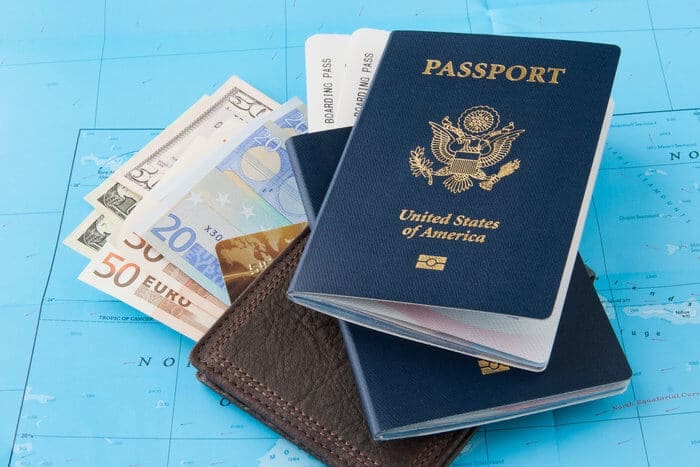IRS Currency Exchange Rates for Expat Tax Returns
November 9, 2023
If you are a US citizen living abroad, you are required to file your annual taxes based on your worldwide income, not merely income earned in the US. In most cases, this will bring IRS currency exchange rates into play.
For your expat taxes, any foreign-earned salary, as well as foreign-earned interest, dividends, pensions, capital gains, annuities, or IRA distributions, is subject to the long arm of Uncle Sam’s tax collector.
Your global income must be reported in US Dollars (USD), which means all foreign-sourced income (and expenses), regardless of type, must be converted from its functional currency to USD.
In this article, we will guide you through how best to convert foreign asset values to USD, and what to consider when filing your tax return.
Nomad Capitalist is a turnkey solution for offshore tax planning, dual citizenship, asset protection, and global diversification. Find out more here.
Functional Currency?
Before we get into the details, let’s first clarify that the “functional currency’’ is the currency of the primary economic environment in which an entity operates.
If you live and work in China, for instance, it’s likely your wages are paid in Chinese Yuan (CNY). Or, if you own a Chinese-based bank account, that bank’s primary economic environment is China, so its functional currency would also be CNY.
For companies, it is the main currency used to conduct business. Even if you trade in multiple currencies, they have to be converted into the functional currency before reporting.
Converting Foreign Asset Values to USD
To calculate the US dollar value of foreign assets, take the foreign amount and multiply it by the appropriate currency exchange rate.
That seems simple enough, but where do you find the correct exchange rate? How do you know an asset’s value? Are there approved IRS currency exchange rates you can use?
IRS guidelines for currency conversion seem somewhat confusing. On its “Foreign Currency and Currency Exchange Rates” page, the IRS advises taxpayers to use whatever exchange rate applies on the date of a particular transaction.
According to the IRS, “you [the taxpayer] must immediately translate into dollars all items of income, expense, etc. (including taxes), that you receive, pay, or accrue in a foreign currency. Use the exchange rate prevailing when you receive, pay, or accrue the item.”
The above statement is also in IRS Publication 54, (Pub 54) “Tax Guide for U.S. Citizens and Resident Aliens Abroad.” Expats and alien resident taxpayers rely on these instructions when completing their income tax returns. Pub 54 also advises taxpayers (on page 4) to perform the foreign-to-USD currency conversion on the date of the transaction.
But in both cases, which exchange rate to use seems to be your choice: if there is more than one exchange rate, use the one that most properly reflects your income. As to where you can find these rates, the IRS states that “you can generally get exchange rates from banks and U.S. Embassies.”
While no specific banks or embassies are mentioned, there are links to three popular currency exchange sites: oanda.com, xe.com and x-rates.com.
If you need historical rates, meaning exchange rates from any day other than the 31st of the current year, those are available on each site as well.
Reporting Maximum Value
Before you can convert your foreign asset’s value into USD, you must first determine its maximum value. This is simply a reasonable approximation of the greatest value of currency or non-monetary assets in the account during the calendar year.
For expats and taxpayers with foreign assets, if you meet certain threshold amounts, you must report these on Form 8938, “Statement of Specified Foreign Financial Assets,” and include it with your 1040-NR tax return. The types of foreign assets to be reported include:
- Financial accounts maintained at financial institutions outside the United States, such as bank accounts, investment accounts, and mutual funds.
- Stocks, bonds or other securities issued by a non-U.S. person and not held through an investment account.
- Any interest in a foreign entity, such as a foreign corporation, foreign partnership, or foreign trust.
- Any financial instrument or contract that has an issuer or counterparty that is not a U.S. person.
Valuing Foreign Financial Accounts
The IRS says that you may rely on periodic account statements for the tax year to report a financial account’s maximum value unless you know or have reason to know (based on readily accessible information) that the account statements do not reflect a reasonable estimate of the maximum account value during the tax year.
Valuing Other Foreign Assets Not Held in Financial Accounts
For an investment asset that is “not a financial account maintained in a financial institution” but is otherwise held for investment, you may use the value as of the last day of the tax year unless you know or have reason to know that the value does not reflect a reasonable estimate of the maximum value of the asset during the year.
For example, you may own a publicly-traded foreign stock not held in a financial account. As of December 31st, the converted-to-USD fair market value is $100,000.
Suppose, however, that based on daily price information that is readily available, the 52 week high trading price results in a maximum value of the stock (as converted to USD) of $150,000. This higher amount is the value you must report for US tax purposes.
IRS Currency Exchange Rates
The above two scenarios provide guidance on computing maximum value, but they say nothing about the IRS currency exchange rate to be used. The instructions for Form 8938, “Statement of Specified Foreign Financial Assets,” however, do offer specifics with respect to currency exchange rates.
Page four of the instructions under, “Valuing specified foreign financial assets,” state that “the value of the foreign financial asset, during the tax year or on the last day of the tax year, is the asset’s fair market value.”
The instructions further define fair market value as “the maximum value of your beneficial interest” in whatever the foreign asset is – whether it’s an estate, pension plan, or deferred compensation plan – as of the last day of the tax year.
So, once the maximum value of the asset is determined in its foreign currency, it then must be converted into US Dollars. Form 8938 instructions say that “in most cases, you must use the US Treasury Bureau of the Fiscal Service foreign currency exchange rate for purchasing US Dollars,” which is found on the US Treasury’s website here.
Through the US Treasury Bureau, you can not only access the current exchange rate as of December 31st but also historical exchange rates. Prior years, divided into quarters, are available as far back as 2001.
Both current and historical tables list exchange rates for just about every country from Afghanistan to Zimbabwe.
Other Currency Exchange Rate Sites
Despite what Form 8938 says about “most cases” above, there is room for other choices, because if no US Treasury Bureau of the Fiscal Service exchange rate is available, “you must use another publicly available foreign currency exchange rate.”
If you do use some other publicly available rate, you must disclose the rate as well as its source. If – for some reason – the foreign country where your assets are based uses multiple exchange rates, you must use the rate that “would apply if the conversion into USD took place on the last day of the calendar year.”
Publicly available foreign currency exchange rates can be found on the sites previously mentioned: oanda.com, xe.com and x-rates.com.

Filing the FBAR and Currency Exchange Rates
As an expat, you may have more than the usual load of paperwork that taxpayers must deal with when it comes to US taxes. Besides your regular return Form 1040-NR and schedules, you also may have to file Form FinCEN 114, “Report of Foreign Bank Accounts and Financial Accounts” (FBAR).
FinCEN is the shortened name for the Financial Crime Enforcement Network, and it is a Bureau of the US Treasury Department. It was created in 1990 to enforce the provisions of the “Bank Secrecy Act” (BSA), passed in 1970.
The BSA was enacted to aid the US government in tracking large, illicit deposits of cash and negotiable instruments used in money laundering schemes.
In later years, it was critical in the war on drugs by helping expose large drug trafficking operations. Some provisions of the BSA were amended by the Patriot Act to give the Treasury more bite in order to thwart the financing of terrorist activities.
Who Must File an FBAR
The FBAR replaced Form TD F 90-22.1 (“Report of Foreign Bank and Financial Accounts”) in 2013. You must file an FBAR if you have a financial interest in or are a signature authority over a foreign financial account or accounts whose combined value is $10,000 or more in any calendar year.
Foreign financial accounts include not only bank accounts, but brokerage accounts, mutual funds, trusts, or other types of foreign accounts, including some foreign retirement arrangements.
Any qualifying foreign account located outside of the 50 states, Washington, DC, US possessions, and tribal territories is considered a “foreign” account for FBAR purposes.
There are some notable exceptions to FBAR, including:
- Owners and beneficiaries of US IRAs;
- Participants in and beneficiaries of tax-qualified retirement plans;
- Certain individuals with signature authority over, but no financial interest in, a foreign financial account;
- Trust beneficiaries (if a US person reports the account on an FBAR filed on behalf of the trust); and
- Foreign financial accounts maintained on a United States military banking facility.
The FBAR should not be included with your tax return. It must be filed separately online via theBSA E-Filing System by April 15th. If you miss that filing deadline, FinCEN will grant an automatic six month extension to October 15th.
FBAR IRS Currency Exchange Rates
For the FBAR, use the maximum valuation that is approximate to the asset’s greatest value during the calendar year to determine the foreign value to be converted to USD. You may rely on periodic statements if you have them.
For conversion into USD, FBAR instructions direct you to use the Treasury’s Financial Management Service Rate, or if that’s not available, you may use another verifiable exchange rate.
Additional Filing Considerations – Form 8938
Filing the FBAR does not necessarily exempt you from also having to file Form 8938, “Statement of Specified Foreign Assets.”
There are significantly higher thresholds of total asset value required before you need to file Form 8938. Amounts vary and are dependent upon your filing status (single, married filing separately, or married filing jointly) and whether you are a US resident or US taxpayer living outside of the US.
For unmarried resident taxpayers, you must file if your total asset value exceeds $50,000 on the last day of the tax year and was more than $75,000 at any time during the year. For US residents who are married filing jointly, the thresholds are $100,000 and $150,000, respectively.
The thresholds for unmarried, non-US resident taxpayers are $200,000 and $300,000, and for married filing jointly non-US residents, the thresholds are $400,000 and $600,000. In both situations, for married taxpayers filing separately, the threshold amounts are the same as for unmarried taxpayers.
Form 8938 Currency Exchange Rates
As with the FBAR, the form instructions tell you to use the maximum valuation approach when preparing Form 8938. With respect to the currency exchange rate, the instructions direct you to use the applicable rate published on the Treasury website’s Financial Management Service Rate. If that rate is unavailable, you may use any other verifiable exchange rate.
One additional guideline provided in 8938 is the “Currency Determination Date.” The instructions state that you should use the currency exchange rate on the last day of the tax year to figure the maximum of a specified foreign asset, and you should “use this rate even if you sold or otherwise disposed of the foreign financial asset before the last day of the tax year.”
While it appears there are multiple guidelines in various IRS publications with respect to what foreign currency exchange rates should be used when converting asset values into USD, the agency does state on its website that it has no official exchange rate and generally will accept any posted exchange rate that is used consistently.
To find out more about our offshore tax planning, dual citizenship, asset protection, and global diversification strategies, reach out here.


FEIE vs Foreign Tax Credit: Which Works Best for US Expats?
If you’re a successful American living overseas or planning to become one, you already know that Uncle Sam doesn’t care how far you roam – as a US citizen, your global income is still on the IRS’s radar. Fortunately, you’re not powerless. US expats have two powerful tools to legally reduce or even eliminate that […]
Read more

Capital Gains Tax on Real Estate in the United States
For most people, buying a home is the single largest financial commitment they’ll ever make – and often, one of the most stressful. Yet, for many US citizens, home ownership remains a cornerstone of the American Dream. Whether it’s about financial security, independence or building generational wealth, millions strive to get on the first rung […]
Read more

Taxes in Portugal: The Ultimate Guide
Mention ‘tax’ and ‘Portugal’ in the same breath, and for years, the conversation would inevitably turn toward the almost mythical benefits of the Non-Habitual Resident (NHR) regime. Stories of near-zero tax on foreign income became part of the relocation pitch for Lisbon and the Algarve, drawing in thousands of would-be residents. It’s believed over 74,000 […]
Read more



